Thessaloniki: The Glorious Heart of Northern Greece
Thessaloniki: a name that conjured up an exotic ancient place that was in my imagination for years. Thessaloniki is Greece’s second city with all its antiquity now a beating heart of culture, cuisine and heritage with the diversity of people that have come through millennia.
Cassander, King of Macedonia who had married Alexander the Great’s half-sister named it after his wife. This king however was the man it is thought might have poisoned Alexander IV the young son of Alexander the Great who had died whilst out of Greece when still conquering the then known world.
We flew into Makedonia Airport and were soon assimilating the architecture and indeed the obvious archaeological remains of the city en route to our hotel.
Thessaloniki lies on the northern fringe of the Thermaic Gulf on its eastern coast and is bound by Mount Chortiatis on its southeast. The Old Town and literally the Upper Town, the heritage listed district north of Thessaloniki‘s city centre that was not engulfed by the city’s great fire of 1917 was declared a UNESCO heritage site.
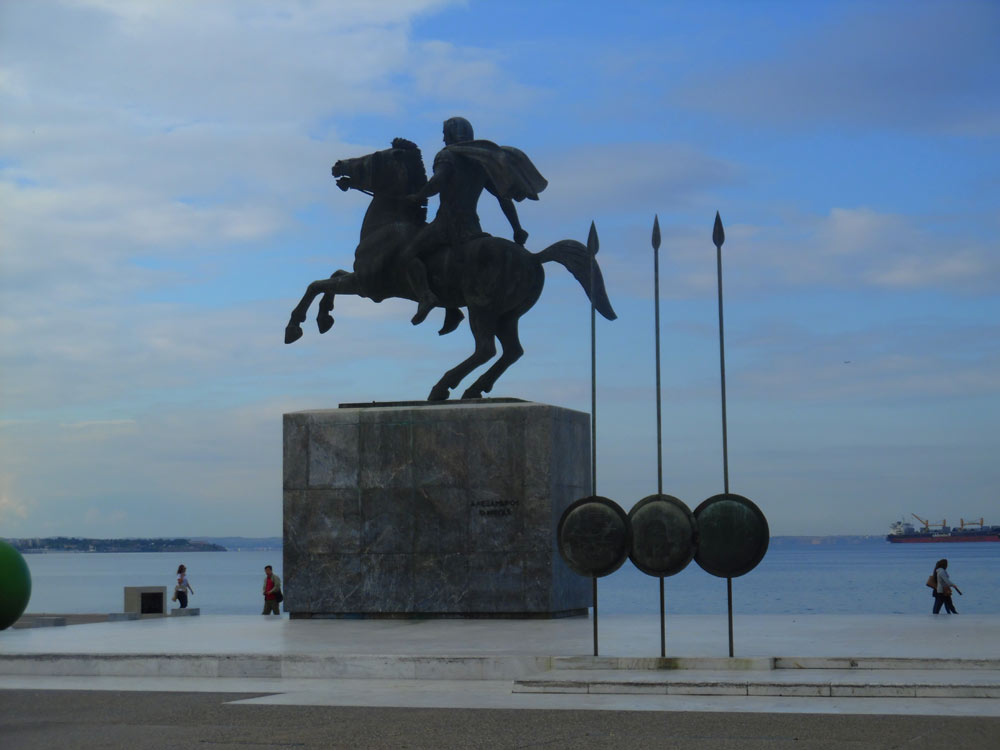
Most roads in the city centre are either parallel or perpendicular to the sea. A simple rule that helps the visitor is that if a street goes downhill, by following it, it will lead you to the sea. For me, I found the great marine parade outstanding and an area to which I gravitated and no wonder, with its iconic wonderful statue of Alexander the Great and the intriguing sculpture of The Umbrellas and the famous White Tower!
On a Sunday morning, nothing nicer than being there and observing the city dwellers all enjoying their exercise by walking, running, cycling with families, maybe fishing or just sitting looking out to the great gulf with its huge commercial vessels.
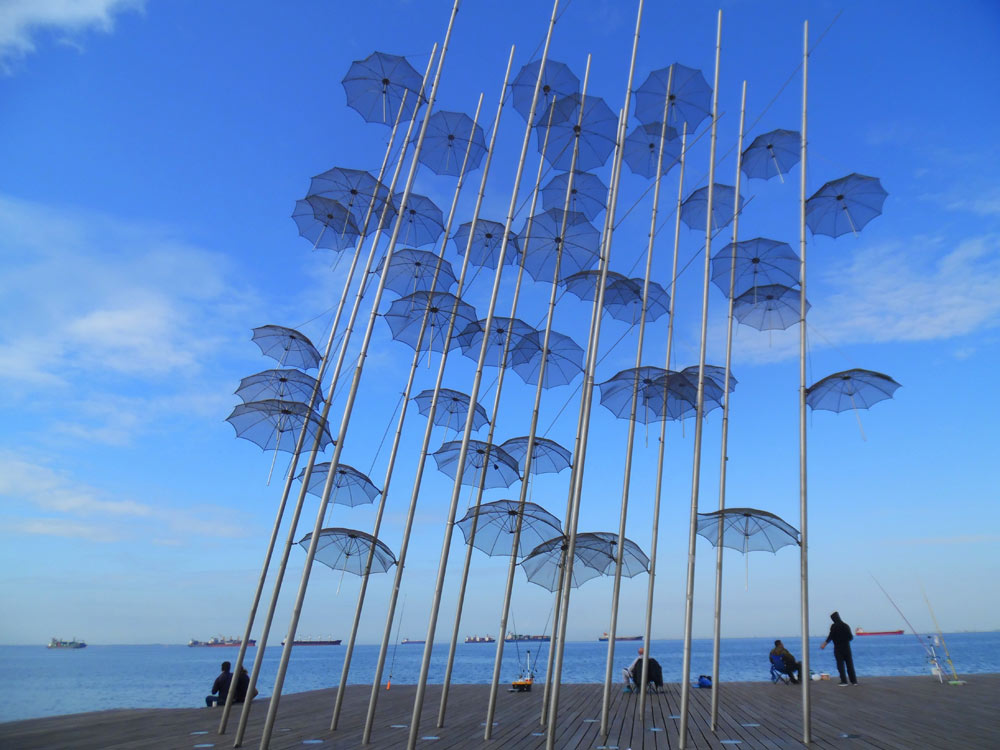
Saloniki, which is how I think of it, is a queen of the Balkans in my perception and with its stunning cuisines and delicatessen shops and cafes and very smart restaurants people are buzzing around.
Tragically, in 1917 there was a great fire which wiped out so much of the Edwardian architecture, but thankfully quite a few great mansions and blocks of flats do still exist and have been renovated. There is some very dull architecture that replaced after the conflagration and in 1978 there was also a big earthquake. Thus, Saloniki has had to constantly redesign itself as it has done since about 315 BC.
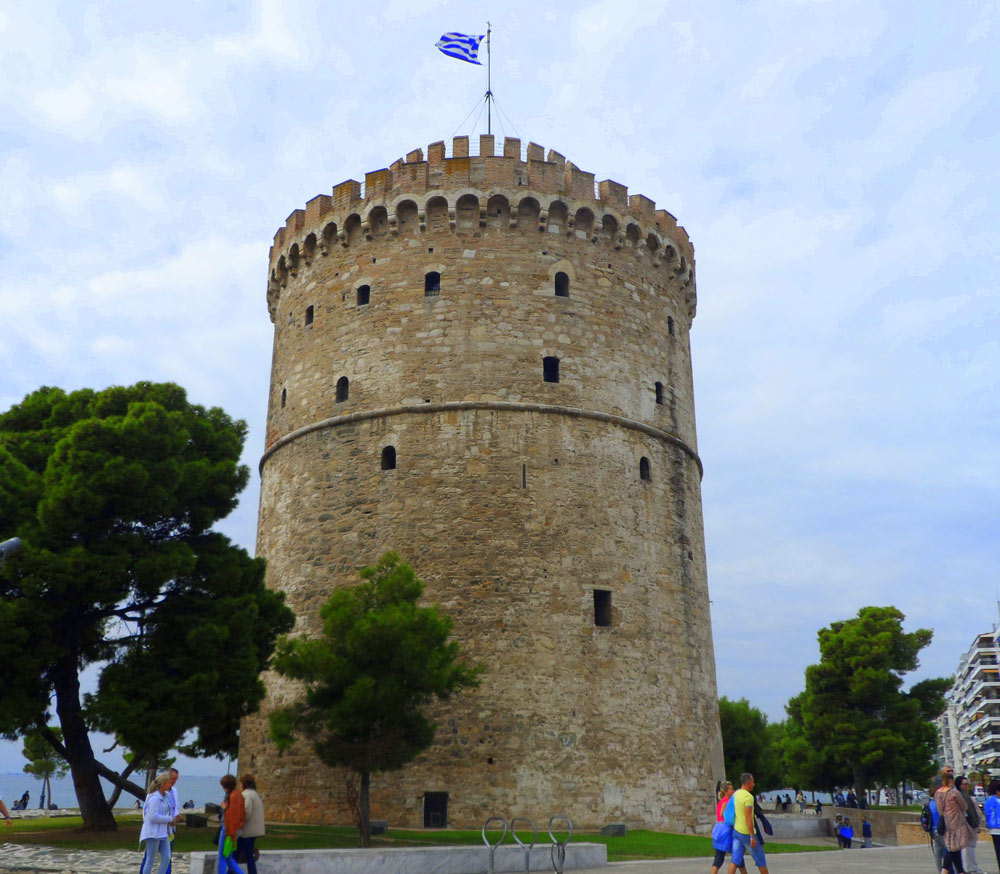
Firstly, there were the Macedonians, followed by the Romans in 168 BC and then 20 years later it becomes the capital of the Roman province of Macedonia. In 42 BC Thessaloniki was declared a ‘free town’ a civitas libera. By the 3rd and early 4th centuries AD the city had become the eastern section of the Roman Empire under Caesar Galerius Maximianus.
His palace and his famous arch are there to remind us of this fact and the enormous Rotunda which so resembles the pantheon of Rome. Fast forward to the 5th to the 12th centuries and Thessaloniki is raided by the Goths, the Persians, the Arabs, the Turks and Bulgarians and then in 1185 AD, the Norsemen occupy the city.
From 1300 to 1430 followed the golden age of the city with great financial and social and intellectual growth – a veritable flowering of this great place. Then the town surrendered to the Venetians who were very swiftly followed by the Ottoman Turks.
When the Catholic Monarchs achieved the removal of Islamic rule in Spain in 1492 they also expelled their Jewish population and the Spanish Sephardic Jews sought sanctuary in Thessaloniki. The Ottomans were practical people and knew how hard-working Jews were and welcomed them to the city. So, in fact there was now a great centre of Christians, Jews and Muslims all living and co-existing side by side in their respective parts of the city.
Walking around on a delightful walking tour organised by Epiculiar we were shown the old back streets, the little shops, the smart cafes that offer meze and wines or coffee and sometimes tea (Oh do I like my tea!).
We looked at old, new, youthful and aged. We went into a wonderful Patisserie called Konstandinidis where we were supervised attempting to make glorious filo pastry cakes which were totally yummy (well the ones previously made by the professionals were!).
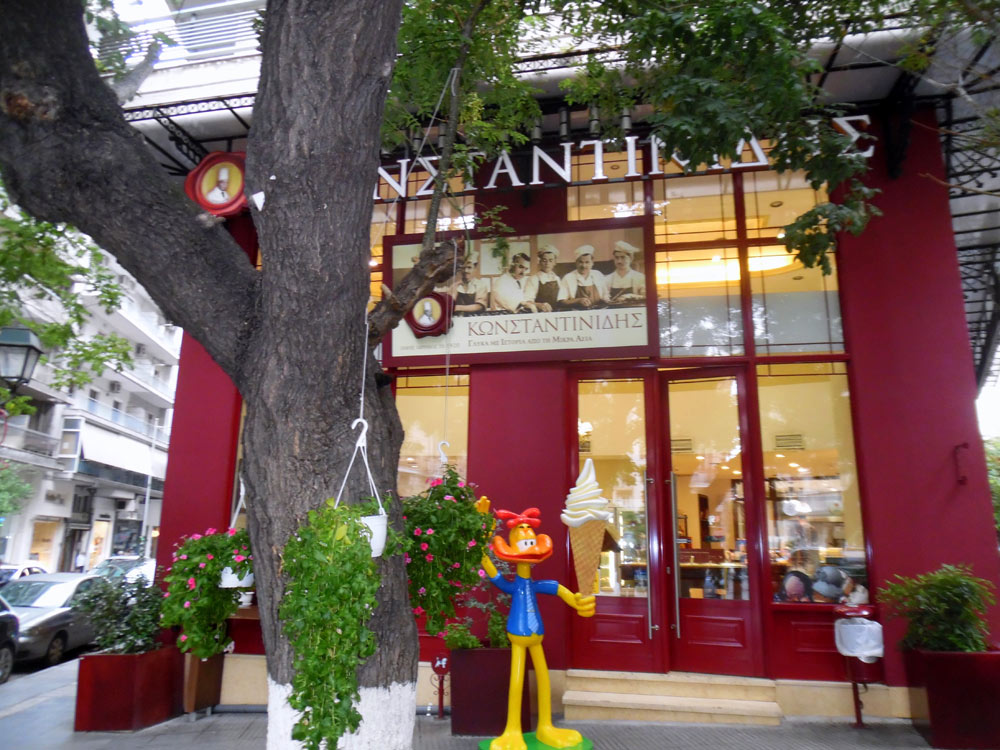
Konstandinidis

We drove up to the city walls and walked down and one could see how this whole city has evolved. We enjoyed some stunning food, but anyway I love Greek food and when it is taken to the heights found in restaurants like Grada Nuevo and Christofer and others then I just want everyone to know!
One of the many legacies of Thessaloniki’s cultural melting-pot past is its strong culinary tradition. The city has come to be regarded as Greece’s gastronomic capital, home to a banquet of Mediterranean flavours. The city is crammed with busy tavernas and mezedopolia, Greek tapas bars which serve a cornucopia of savoury delicacies.
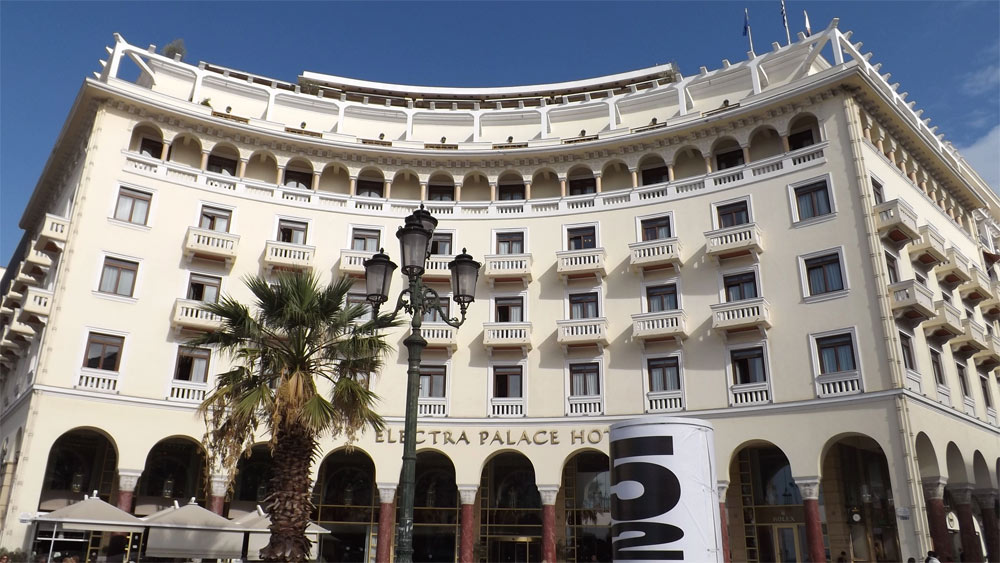
Electra Palace Hotel, Thessaloniki
Its two excellent main markets, Kapani and Modiano are food heaven, crammed with fresh vegetables, meat, fish, delicacies, herbs and spices of all shapes and colours, plus lots of little stand-up eateries.
We just contented ourselves with small tokens of our time there when we visited, but one of them …… was a pot of crystalized oranges which are an absolute favourite with us, to be eaten with a small spoon, or ladled onto good yoghurt!
Despite its rich history, Thessaloniki refuses to be locked in the past. It has a modern, cosmopolitan feel, a busy cultural life with 30 museums and galleries, including the State Museum of Contemporary Art, which houses the Costakis Collection. The Archaeological Museum of Thessaloniki is considered one of Greece’s most important museums. Its collection includes important artefacts from the local area and wider northern Greece.
I just loved sitting in the Garden Terrace restaurant high up on the roof of the Electra Palace Hotel and soaking in the morning sunshine, there is a swimming pool too, people all eating a massive breakfast and looking out on to the calm water of the Thermaic Gulf.
If you consider a City Break in Thessaloniki choose from four stars category hotels upwards to ensure a gracious atmosphere that enhances your visit. To my mind if you can spare four days you would really enjoy this city and its surroundings.
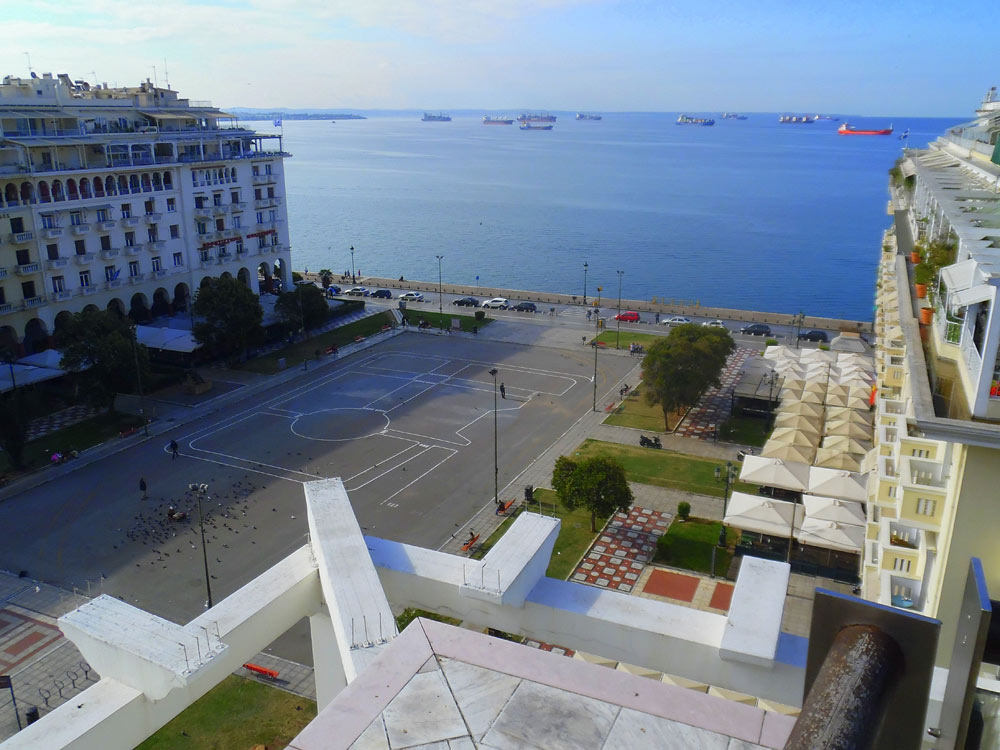
View from Electra Palace Hotel, Thessaloniki
We drove to Vergina and were awe-struck by the magnificent tombs of the Macedonian royal family; the tomb of Philip II of Macedon, the father of Alexander the Great was intact when discovered in 1977 – that is just 40 years ago!
The museum is excellent underground and comprehensive and Vergina is an attractive small place; I just kept imagining Alexander the Great in his youth having to take on the mantle of his suddenly murdered father –perhaps on the cunning instructions of his own ambitious mother. Alexander provided a fitting burial for his father and then was crowned king and changed the course of history in the known world.
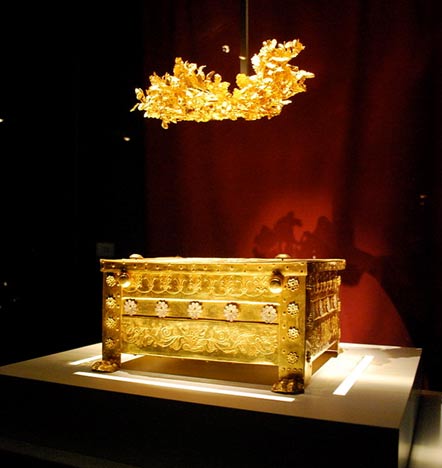
Certainly, drive to nearby Veria which can boast of 2,500 years of history too. At Veria the Apostle Paul conveyed the message of Jesus to the people of Veria and the Thessalonians; one stands on the spot where that is thought to have occurred and it is impressive. We lunched nearby in a splendid restaurant called Grada 12 and were truly delighted with the food.
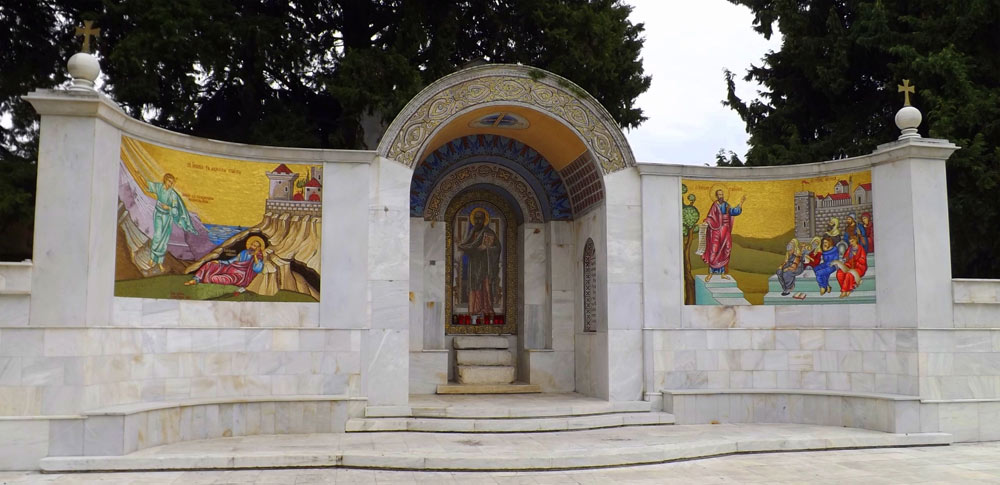
Where St. Paul spoke
In 1912, the Greek Army seized the town on October 26th after five centuries of Ottoman occupation. At last, Thessaloniki became part of Greece, but here lie cemeteries of the great conflict of the First World War that followed. Then, having survived the great fire, events move on to 1922-23 and as a last stage of the Greco-Turkish War the agreement on population exchange between the two countries sees Thessaloniki receive in excess of 300,000 Greeks from Asia Minor including Armenia.
The appalling horror of the German occupation in 1943 led to Nazi Germany sending a massive number of the city’s Jewish population to Auschwitz. At the time of the German occupation, the Jewish population was about 50,000. The Nazis deported more than 45,000 Jews to Auschwitz Birkenau. For those of us who have visited Auschwitz to pay respects this is a truly horrific fact.
Now, however, we are hopefully in the sunlit uplands of the 21st century with greater understanding of the horrors of religious and ethnic enmity and Thessaloniki has remained through all those centuries as a bastion of how our world should work together and prosper.
If the visitor wants to stay in a resort like atmosphere then I would also consider the Hyatt Regency which is near the airport but runs courtesy transfers to the city all the time. It has wonderful pools, garden areas and lovely cuisine too.
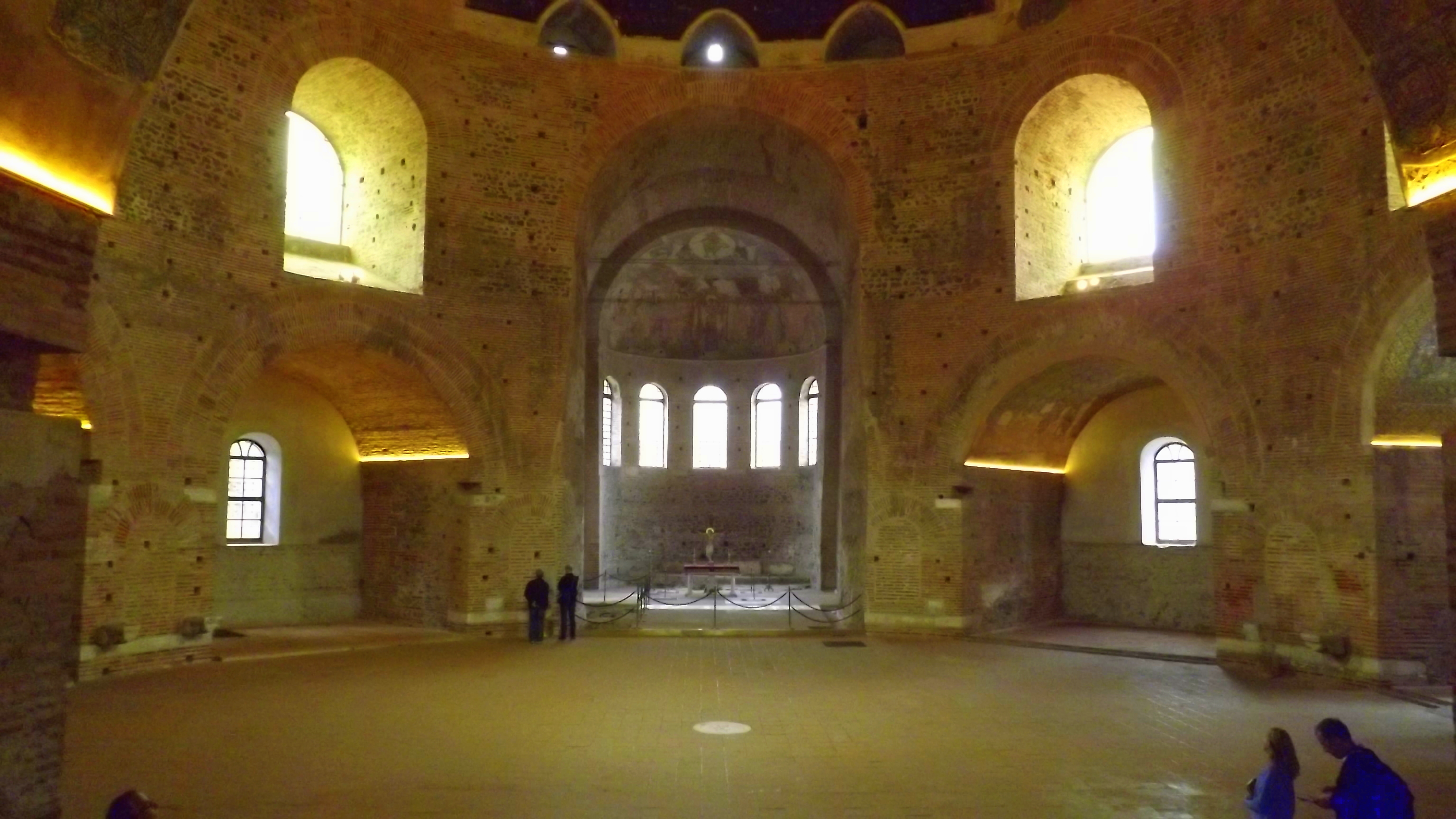
We, however, went on to have the pleasure of a very quick trip to the Halkidiki region south of Thessaloniki and spent a night at the idyllic little town of Olympiada given the name of Alexander the Great’s mother, she of the great ambition.
Alongside this charming town which is just like a big village on a beautiful bay is the stunning archaeological site of ancient Stageira. Stageira is the birthplace of the great Aristotle. Aristotle a giant amongst thinkers of the ancient world was commanded by Philip II of Macedon to teach his son…. Alexander the Great. Aristotle taught Alexander for three years until 340 BC. Thus, you see the relevance and how it all fits in. This archaeological site was only unearthed in 1991.
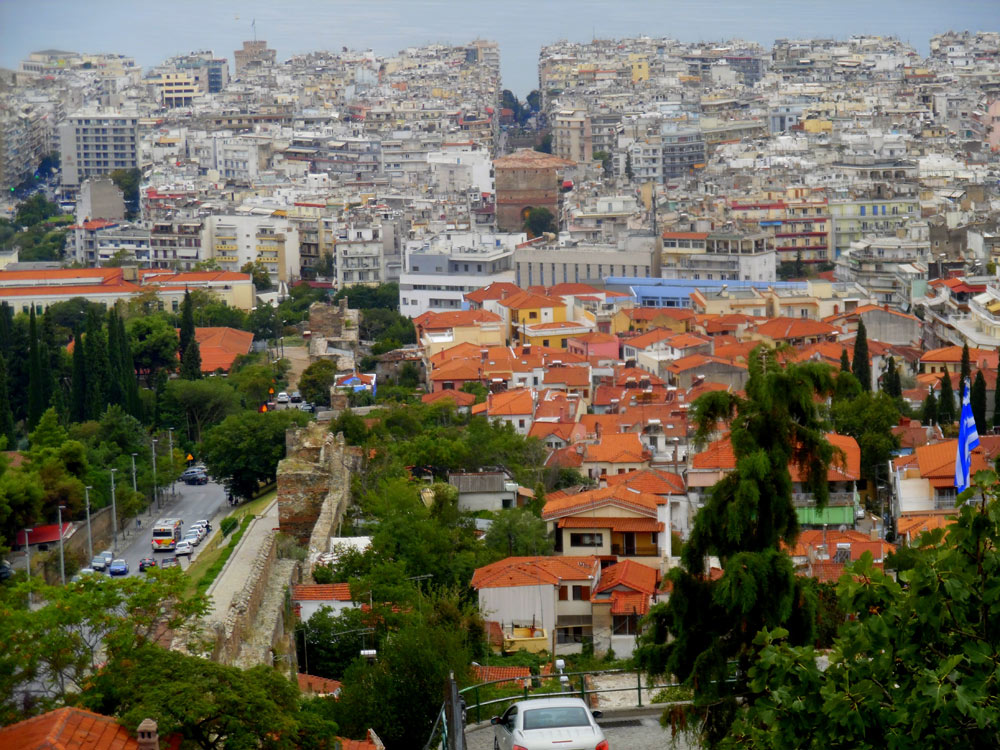
Looking down on the city
One must respect and understand its great ancient past and how it stands proudly today as Greece’s Second city. Truly, Thessaloniki is a place of Many Stories but One Beating Heart. Check out my gallery of the visit.




